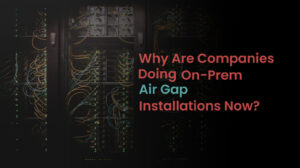BrainBlog by Jason English, for Replicated | Part 1 of the Intellyx On-Prem Innovation Series
Software ate the world. Then SaaS started eating software. Then, cloud started enveloping SaaS.
 Now, even one flavor of cloud is no longer good enough for most highly distributed software applications. To be agile and responsive, you must orchestrate the delivery of applications across some kind of hybrid public or private cloud, which could be provisioned from service providers, called via APIs from a marketplace, or deployed into ephemeral cloud-native microservices.
Now, even one flavor of cloud is no longer good enough for most highly distributed software applications. To be agile and responsive, you must orchestrate the delivery of applications across some kind of hybrid public or private cloud, which could be provisioned from service providers, called via APIs from a marketplace, or deployed into ephemeral cloud-native microservices.
The push for off-premises migration of software has never been stronger — by some architectural estimations, it’s taken for granted that most applications should move to the cloud in the next couple of years if they are not there already.
But wait, why are some companies hitting that big red disconnect button today, and doing on-prem air gap software installs?
The Origins of Air Gapping
If you are new to the concept of air gapping, that’s OK. Old hacks like myself with some history of supplying software for banks and government agencies have encountered the need for air gapping — basically, installing onto a system that is not connected to the Internet at all — nor any network that could offer any port for security breaches to occur.
Basically, air gapping is the purest form of on-premises software delivery, in that absolutely everything needed for that software to run must be packaged for local installation and ready to run disconnected from any network.
No calls out to external authentication providers. No remote license keys. No checking for version updates and patches. Sneakernet installation, we called it, meaning someone would need to walk in with a disk or drive and manually execute the install onto the target air gapped system.
Once on-site, ideally, this would have been a double-click, plug-and-play event — but often, the configuration, install, and patching process for one of these systems was a Sisyphean effort.
Vendor product experts and customer sysadmins would work together to run batch scripts, tweak manifest settings and validate the system, sometimes through terminal consoles, once it went live. Mess one step up, or realize the need for a later product update, and both sides would be looking at another extended and costly consulting visit.
It’s not hard to tell why air gapping was reserved for only the most mission-critically remote use cases. Many software vendors simply chose to opt out of this side of the market, waiving their right to work in such secure demesnes in favor of less troublesome Internet-friendly SaaS business models.
On–Prem Isn’t Making a Comeback – It Never Went Away
If you were to believe pundits who made SaaS and cloud computing predictions ten years ago, we’d be operating everything-as-a-service by now. But for many kinds of secure work, SaaS isn’t a viable option, and even connections to external services and APIs are undesirable…
Read Part 1 of the Intellyx On-Prem Innovation Series on Replicated.com here: https://www.replicated.com/blog/why-are-companies-doing-on-prem-air-gap-installations-now
https://www.replicated.com/blog/why-are-companies-doing-on-prem-air-gap-installations-now
© 2021, Intellyx, LLC. Intellyx retains editorial control over this content. At the time of publishing, Replicated is an Intellyx client. Image credits: Photo by Taylor Vick on Unsplash (courtesy of Replicated)



